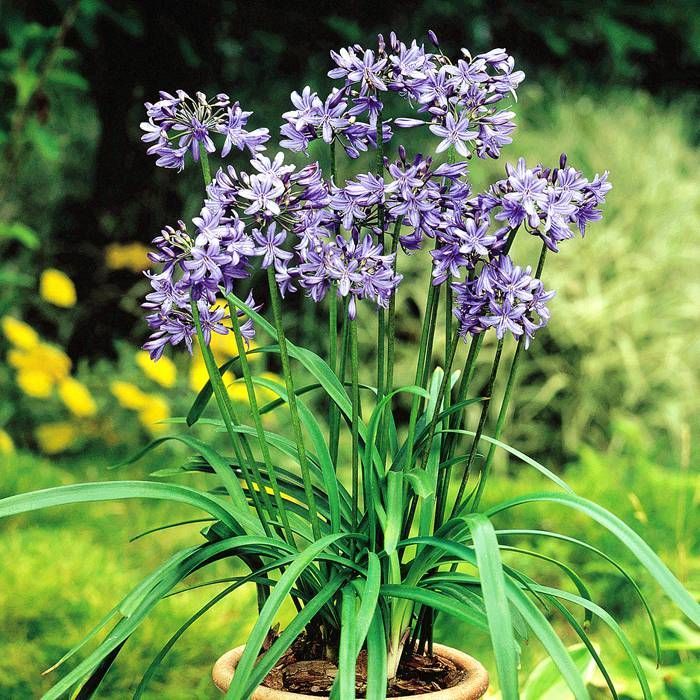Mastering the Art of Agapanthus Care: Important Actions for Healthy And Balanced Growth and Lively Flowers
In the realm of gardening, the growing of agapanthus stands as a fulfilling endeavor for those that seek to nurture these sophisticated blooming plants. With their striking blooms and graceful vegetation, agapanthus has captured the interest of garden enthusiasts worldwide. However, achieving optimal development and dynamic blooms calls for a nuanced approach that encompasses various important steps. From choosing the appropriate selection to mastering trimming strategies, the trip towards cultivating prospering agapanthus plants is complex and holds the essential to opening the complete possibility of these herb gems.

Selecting the Right Agapanthus Variety

When picking the best Agapanthus range for your garden, consider elements such as climate viability, blossom shade, and development practice. Agapanthus, frequently referred to as Lily of the Nile or African lily, is available in a variety of colors ranging from shades of blue and purple to white. Select a flower color that matches your existing garden palette to produce a harmonious landscape. Additionally, take into consideration the climate in your region to ensure the Agapanthus range you select can prosper in your details problems. Some selections are a lot more forgiving of cool temperature levels, while others favor warmer environments. Understanding the growth practice of different Agapanthus selections is critical for correct positioning within your garden. Some ranges have a clumping growth practice, suitable for containers or boundaries, while others have an even more spreading nature, suitable for ground cover or mass growings. By very carefully examining these elements, you can select the ideal Agapanthus variety to boost the elegance of your yard.
Perfect Growing Conditions
Considering the optimum ecological needs is crucial for effective Agapanthus cultivation. Agapanthus plants are delicate to cool temperature levels and need to be secured from frost during winter months.
To ensure healthy and balanced development and vibrant blooms, plant Agapanthus light bulbs at a depth of concerning 2-4 inches and space them 8-12 inches apart. Mulching around the base of the plants assists preserve dampness and subdues weed development.
Watering and Feeding Tips
Maintaining appropriate moisture levels and giving necessary nutrients are crucial components in the care program for Agapanthus plants. When it involves watering Agapanthus, it is crucial to strike a balance. These plants like continually moist soil but are susceptible to root rot if overwatered. Throughout the expanding period, water deeply when a week, making sure the soil is well-draining to protect against waterlogging. In hotter climates or during periods of dry spell, even more regular watering may be required to maintain the dirt uniformly wet. Nevertheless, reduce watering in the winter season to stop water logged conditions.
Fertilizing Agapanthus is vital for promoting healthy and balanced growth and respected blooms. Use a well balanced fertilizer, such as a anonymous 10-10-10 formula, in the early springtime as brand-new growth arises. Repeat this application every 6-8 weeks throughout the growing season. you can look here Stay clear of extreme fertilization, as it can bring about lavish vegetation at the cost of blooms. Always comply with the producer's guidelines for proper dilution and application techniques. By following these watering and feeding suggestions, you can guarantee your Agapanthus plants prosper and produce lively, durable blooms.
Trimming Methods for Agapanthus
Pruning Agapanthus plants at the proper times and with correct techniques is vital for keeping their health and wellness and advertising optimum growth and flowering. The perfect time to trim Agapanthus is in late winter months or early springtime prior to new growth arises.
Deadheading invested blossoms can likewise redirect the plant's power right into producing even more flowers instead than setting seeds. If you desire to gather seeds for proliferation, leave some blossoms to mature and dry on the plant.
Remember to use tidy, sharp devices to make precise cuts and lower the risk of presenting diseases. Agapanthus. Routine trimming will certainly assist maintain your Agapanthus looking healthy and balanced and neat while guaranteeing an abundant screen of lovely flowers
Dealing With Typical Pests and Conditions
After guaranteeing proper trimming techniques for Agapanthus, it is necessary to resolve usual parasites and diseases that can influence the wellness and vitality of these plants. Agapanthus plants are typically durable however can still succumb certain problems. One usual insect that influences Agapanthus is the Agapanthus gall midget. This small, orange fly lays its eggs in the foliage, bring about distorted development and blossom buds that stop working to open up. To fight this pest, trim and ruin any type of afflicted plant components and consider utilizing insecticidal soap.
Another usual issue is fungal fallen leave place, which provides as dark lesions on the leaves. To avoid fungal illness, make sure excellent air flow around the plants, avoid overhead watering, and eliminate any kind of infected leaves quickly. Furthermore, Agapanthus plants can deal with origin rot if they are planted in inadequately draining pipes dirt. To avoid this, plant Agapanthus in well-draining soil and stay clear of overwatering. By being alert and taking timely activity against bugs and diseases, you can aid your Agapanthus plants thrive and produce look at this site lively flowers.

Conclusion
Finally, understanding the art of agapanthus care involves picking the appropriate variety, offering suitable growing problems, appropriate watering and feeding, ideal trimming techniques, and dealing with usual insects and illness. By adhering to these necessary steps, you can make sure healthy and balanced development and lively blooms for your agapanthus plants. Bear in mind to regularly monitor and maintain your plants to promote their general wellness and longevity.
To ensure healthy and balanced development and dynamic blossoms, plant Agapanthus bulbs at a deepness of concerning 2-4 inches and room them 8-12 inches apart. By complying with these watering and fertilizing ideas, you can guarantee your Agapanthus plants thrive and generate vibrant, long-lasting blossoms.
One typical bug that impacts Agapanthus is the Agapanthus gall midget. In addition, Agapanthus plants can suffer from root rot if they are grown in improperly draining dirt. By complying with these vital steps, you can ensure healthy and balanced growth and dynamic flowers for your agapanthus plants.
 Shaun Weiss Then & Now!
Shaun Weiss Then & Now! Jurnee Smollett Then & Now!
Jurnee Smollett Then & Now! Michael Fishman Then & Now!
Michael Fishman Then & Now! Tina Louise Then & Now!
Tina Louise Then & Now! Bernadette Peters Then & Now!
Bernadette Peters Then & Now!